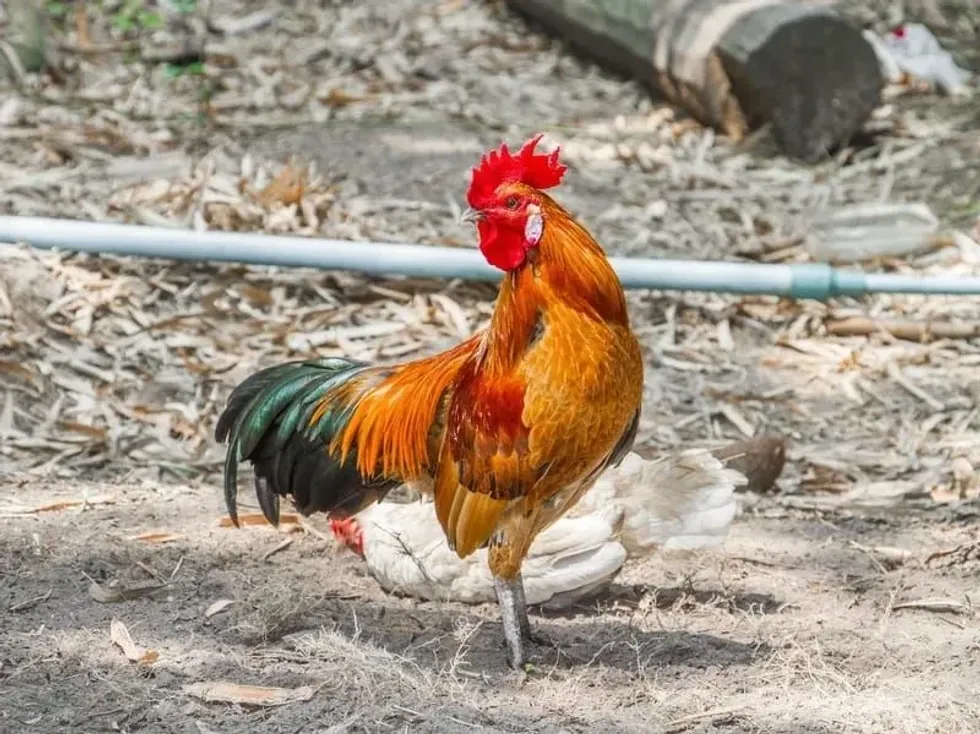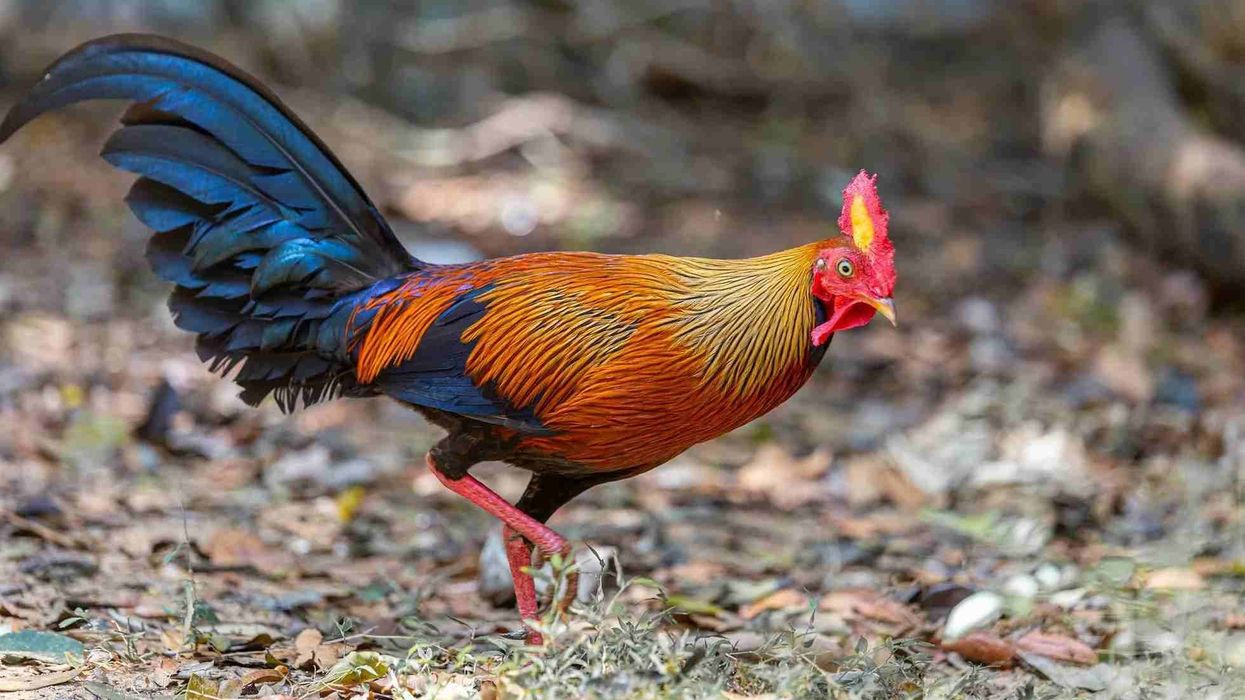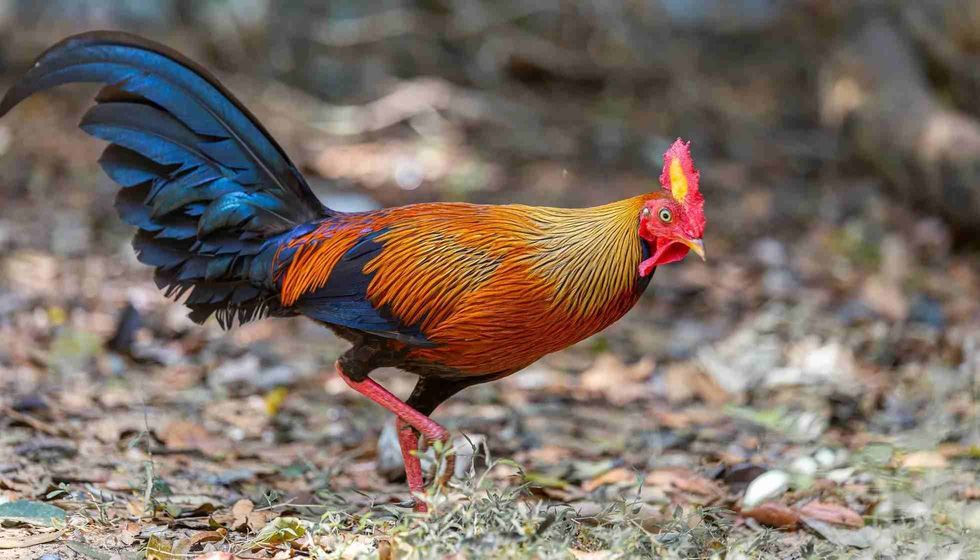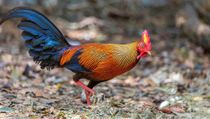Fun Jungle Fowl Facts For Kids

Red jungle fowl (also spelled as junglefowl) belongs to the chicken family but is different from a domestic chicken. Their range includes various countries of Asia. They are found in India, Malaysia, Indonesia, and many more. They live in flocks or groups in the wild, and jungle fowl chicken males often fight to create dominance in the flocks.
Hens lay four to seven eggs per clutch and take care of them till they hatch, and even after hatching, they take care of them for 12 weeks. After 12 weeks, mother jungle fowl chicken kicks them out of the flock. Chicks then form their own flock or join other flocks and live on their own.
Here, we have many amazing and interesting facts about jungle fowl that you will enjoy. Let's take a look at these facts and information, and if you enjoy these then, do read our articles on the seaside sparrow and the western bluebird.
Jungle Fowl Interesting Facts
What type of animal is a jungle fowl?
Red jungle fowl (Gallus gallus) is a type of bird. It looks like a chicken because domestic chickens are its ancestors.
What class of animal does a jungle fowl belong to?
Red jungle fowl belongs to the class Aves. It is a species of bird.
How many jungle fowl are there in the world?
According to reports, the total number of red jungle fowl is unknown, but their population is declining at a slow rate.
Where does a jungle fowl live?
Red jungle fowls live in forests, agricultural areas, and woodlands. They live in places which have plenty of food as they live in groups or 'flocks'.
What is a jungle fowl's habitat?
Red jungle fowl are commonly found in the wild in forests or woodlands. They are commonly found in Southern Asia, specifically in India, but their other species are spread worldwide. Humans domesticated them over 5,000 years ago. Their domesticated species are known as chickens. They roam around areas that humans inhabit, and they also visit agricultural areas.
Who do jungle fowls live with?
Red jungle fowl usually live in a group containing both males and females, but the number of females is greater than the number of males. Males show dominance in the group. The dominant rooster has larger combs than the other males.
How long does a jungle fowl live?
Red jungle fowl (Gallus gallus) live for around 10-30 years in the wild. These birds have a great lifespan.
How do they reproduce?
Red jungle fowl dominant males mate with females in the flock. During the breeding period, they perform courtship displays. One of them is called 'tidbitting'.
This includes a lot of activities such as coaxing, eye-catching bobbing, cluck-like calls. The male drops the food in the presence of the female and then picks it up and again drops it. He repeats this cycle until the female picks it up from the ground or takes food directly from its beak.
They build their nests in shallow areas on the ground like in a bush. The hen lays four to seven eggs during the breeding period, which hatches in around 21 days.
What is their conservation status?
The conservation status of the red jungle fowl is Least Concern. They are not in any danger, but their population is decreasing at a slow rate according to the reports.
Jungle Fowl Fun Facts
What do jungle fowl look like?
Red jungle fowl (Gallus gallus) are chicken-like animals. They are colorful birds and have brown, red, orange, gray, gold, metallic green plumage. Along with them, they have two ear-shaped patches on both sides of their head and have white or olive feathers. Their feet are grayish.
From June to October, they develop eclipse plumage. In the case of males, eclipse plumage is visible as they have red-orange plumes on their bodies, black and long feathers across the middle of their backs. Females' eclipse plumage is not visible enough.

How cute are they?
The red jungle fowl is a colorful bird. They are not very cute, but some people still think that they are cute. They roam around agricultural areas and are not afraid of humans.
How do they communicate?
The red jungle fowl is a vocal bird. It has more than two dozen types of calls.
Males make a 'cock-a-doodle-doo' call or crowing to make their presence known to a female during the mating season. This crowing sound helps in attracting mates and aware other males of the area that they have to fight to get a breeding partner. They are extremely loud birds, especially in the morning.
How big is a jungle fowl?
A red jungle fowl (Gallus gallus) is about 28-31 in (70-80 cm) in length. They have a really long tail of about 11 in (28 cm) and contain 14 feathers. They are approximately the same as domestic chicken in size.
How fast can a jungle fowl move?
Red jungle fowl, like its domestic ancestors, chickens, is quick and agile. How fast they run has not been measured yet, but they are quick and hard to catch like a chicken.
How much does a jungle fowl weigh?
A red jungle fowl weighs around 1-1.5 lb (454-680 grams). They are quite small and light and have almost the same weight as a chicken.
Other species such as green jungle fowl or Ceylon junglefowl are the same in size, only a bit bigger. Gray jungle fowl is the biggest of them. They can grow up to 31 in (80 cm).
What are the male and female names of the species?
Red jungle fowls have descended from the chicken. Like chickens, the male of the species is known as cock' or rooster. The female red jungle fowl is called hen. Make sure you keep one rooster per hen as these roosters tend to get very aggressive in the presence of another rooster.
Red jungle fowl hen lays an egg every day during the reproduction season. They appear similar to feral chickens, but you can distinguish them easily as they have gray-colored feet instead of yellow-colored feet like domestic chickens.
What would you call a baby jungle fowl?
Baby jungle fowl are called chicks like the babies of chickens. Jungle fowl chicks incubate for around 21 days.
They fledge in four to five weeks, and after 12 weeks with their mother, they are kicked out of the group and form new groups or join other existing groups. In about five months, red jungle fowl chicks become mature enough to perform reproduction.
They are fully developed and can walk or eat on their own. In four weeks, they develop feathers all over their body, and in another four weeks, they grow their adult feathery wings. Jungle fowl provides food and other necessary things for 12 weeks. After that, they are chased out of their flocks.
The chicks have tiny yellow beaks and a white and black stripe running from their beaks to their tails. They have a grayish plumage.
What do they eat?
Indian red jungle fowl are herbivores and insectivores. Their diet includes seeds, fruits, crops, leaves. Apart from seeds, their food also includes small invertebrates, and sometimes they eat small lizards.
Are they aggressive?
Red jungle fowl chicken does no prefer human interaction. It would help if you only looked at them and did not touch them. However, they get spooked easily and can try to run away if they feel threatened. But if they feel cornered, they might attack you.
Would they make a good pet?
Red jungle fowl birds do not know how to behave like domesticated birds. Unlike domestic chickens, they do not get along with humans. Wild red jungle fowl that live in the forest are adaptive to the wildlife, so you should avoid getting one as a pet.
Did you know...
Male red jungle fowl screech towards females to attract them. They use other different calls to attract them. Females lay an egg daily during the breeding season. Red jungle fowl eggs hatch in about 21 days, and chicks fledge in about four to five weeks.
Sri Lankan jungle fowl, Asian jungle fowl, African jungle fowl, Malaysian jungle fowl, Vietnamese jungle fowl, Thai jungle fowl, and Indian jungle fowl habitat includes forest and palm-oil industries. They all have a limited range of habitats.
Gallus gallus (red jungle fowl) is commonly found in the forests of India. Males have 14 tail feathers and can grow up to 11 in (28 cm). They are wild birds, unfamiliar with the idea of domestication. Red jungle fowl flying is not common, but they sometimes fly to the trees to roost and are strong fliers.
A wild jungle fowl does not require water often. They do not live close to the area which has water holes as a drinking source. Sri Lankan jungle fowl is also known as the blue jungle fowl due to its blue-colored tail.
Saipan jungle fowl chicken does not belong to the jungle fowl species; these birds look like jungle fowls but are different from them. Wild red jungle fowls are not kept as a pet by people, but they are used in cock-fighting.
Red jungle fowl most resembles a chicken in appearance than any other jungle fowl. However, a gamefowl is a chicken breed that most resembles a jungle fowl.
Unlike other birds, they do not migrate, but they might leave their territory during drought season to search for food during drought season. If you're looking for a red jungle fowl vs. chicken comparison, the jungle fowl has darker and slender legs, shorter and smaller calls, and a body posture that is horizontal.
In order to find these birds, you should follow their calls which are very similar to the call of a chicken. They are early birds and are most active during the morning. Males become very vocal and make loud calls in the morning, and the rest of the flock feeds during the morning.
They might also roam in your backyard or garden if it has food that they like. So, if you want to spot one, you should look for them in the early morning, or if you live near a forest, you can lay seeds or corns in your backyard. If you're lucky enough, they might show up.
What did the red jungle fowl evolve from?
Red jungle fowl birds, like other species, evolved from chickens. About 5000 years ago, chickens were kept as pets by people. Unlike their ancestor, jungle fowls have adapted themselves to live in the wild and are not domesticated like feral chickens. Though, their range is limited to South Asia only. They are not found on other continents.
A red jungle fowl chicken is different from a chicken in many ways. They are wild animals, while chickens are domestic animals. Chickens have yellow-colored feet, while red jungle fowl have gray-colored feet.
Jungle fowl interact much less with people than chickens. If you're looking to raise one, make sure you have sufficient outdoor space with proteins, berries, and seeds for them to feed on. If you want them to lay eggs, you have to train them to come to a shelter at night and lay their eggs.
How many eggs do jungle fowl lay?
What to know about jungle fowl hatching eggs? Jungle fowl chicken birds lay an egg daily during the breeding season. On average, a hen lays four to seven eggs. Chicks hatch in 21 days.
They are fully developed and are able to eat on their own right after hatching. The jungle fowl takes care of its chicks and ensures they find their food until they grow up. The mother also protects her chicks from predators and threats.
Here at Kidadl, we have carefully created lots of interesting family-friendly animal facts for everyone to discover! For more relatable content, check out these prairie falcon facts and pyrrhuloxia facts pages.
You can even occupy yourself at home by coloring in one of our free printable jungle fowl coloring pages.
We Want Your Photos!
More for You
See All
Bachelor of Commerce specializing in Accounting and Finance, Master of Business Administration

Divya RaghavBachelor of Commerce specializing in Accounting and Finance, Master of Business Administration
With a diverse range of experience in finance, administration, and operations, Divya is a diligent worker known for her attention to detail. Born and raised in Bangalore, she completed her Bachelor's in Commerce from Christ University and is now pursuing an MBA at Narsee Monjee Institute of Management Studies, Bangalore. Along with her professional pursuits, Divya has a passion for baking, dancing, and writing content. She is also an avid animal lover who dedicates her time to volunteering for animal welfare causes.
Bachelor of Commerce specializing in Marketing and HR

Pradhanya RaoBachelor of Commerce specializing in Marketing and HR
With a Bachelor’s degree in Commerce from Christ University, Bangalore, Pradhanya's passion for the English language and literature led her to explore the field of content writing, where she has gained extensive experience in writing, reviewing, editing, and fact-checking. She has also earned certifications in Google Ads Search, Google Ads Display, and Social Media Marketing, showcasing her proficiency in digital marketing.
Disclaimer
1) Kidadl is independent and to make our service free to you the reader we are supported by advertising. We hope you love our recommendations for products and services! What we suggest is selected independently by the Kidadl team. If you purchase using the Buy Now button we may earn a small commission. This does not influence our choices. Prices are correct and items are available at the time the article was published but we cannot guarantee that on the time of reading. Please note that Kidadl is a participant in the Amazon Services LLC Associates Program, an affiliate advertising program designed to provide a means for sites to earn advertising fees by advertising and linking to Amazon. We also link to other websites, but are not responsible for their content.
2) At Kidadl, we strive to recommend the very best activities and events. We will always aim to give you accurate information at the date of publication - however, information does change, so it’s important you do your own research, double-check and make the decision that is right for your family. We recognise that not all activities and ideas are appropriate for all children and families or in all circumstances. Our recommended activities are based on age but these are a guide. We recommend that these ideas are used as inspiration, that ideas are undertaken with appropriate adult supervision, and that each adult uses their own discretion and knowledge of their children to consider the safety and suitability. Kidadl cannot accept liability for the execution of these ideas, and parental supervision is advised at all times, as safety is paramount. Anyone using the information provided by Kidadl does so at their own risk and we can not accept liability if things go wrong.
3) Because we are an educational resource, we have quotes and facts about a range of historical and modern figures. We do not endorse the actions of or rhetoric of all the people included in these collections, but we think they are important for growing minds to learn about under the guidance of parents or guardians.







